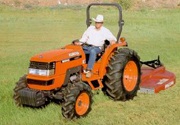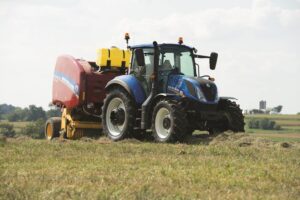Description
Rubber-tired, rear-wheel-drive tractors are designed to pull small to large implements on level to undulating ground. These tractors are usually powered by diesel engines. Gasoline engines are available only in the smallest models. Tractor horsepower ranges from 30 to about 175 but is usually less 140. Tractors less than 30 horsepower are usually used in residential areas. Transmissions can be standard or shift-on-the-go with 8 to 20 forward gears and several reverse gears. Tractors are equipped with a rear-mounted, three-point hitch and a trailing drawbar. The three-point hitch is instrumented to control load, depth, and weight transfer for optimum traction. A few models also have a front mounted three-point hitch. Tractors are equipped with specially designed cabs that are air conditioned and heated. They have power adjusted seats, fingertip adjustment of all controls, and many other conveniences. Tractors without cabs are equipped with roll-over protection structures. Hydraulic systems provide power for steering, brakes, lift capacity for the three-point hitch, and from one to five outlets for remote cylinders and/or motors. Power-take-off shafts operate at 540 or 1,000 rpm. Dual rear wheels provide higher horsepower tractors with added traction, reduced soil compaction, and stability in some situations.
Application
Rear-wheel-drive tractors are very maneuverable and create little soil disturbance when turning. Large rear wheels provide the traction necessary to pull implements in firm to loose soil without undue soil compaction. Small front tires provide the operator with good visibility and are used to steer the tractor. It is important to match tractor size to pulling requirements and size of the implement. Consideration must be given to addition of wheel weights and/or liquid in the rear tires for increased traction. Weights on the front of the tractor are necessary for weight transfer (increased traction) and stability. Tractors are designed to pull either large loads at slow speeds or lighter loads at higher speeds. Field speeds up to 10 mph are possible, but rangeland applications usually vary from 2 to 5 mph. Many attachments are available including front-end loaders. To meet the need for more traction, drive wheels can be added to the front axle (see the section on Front-Wheel Assist Tractors). Soil compaction from tractor operation can be a problem when soil moisture levels are high.
References / Additional Information
See also the description and explanation of Tractors and Torque.




